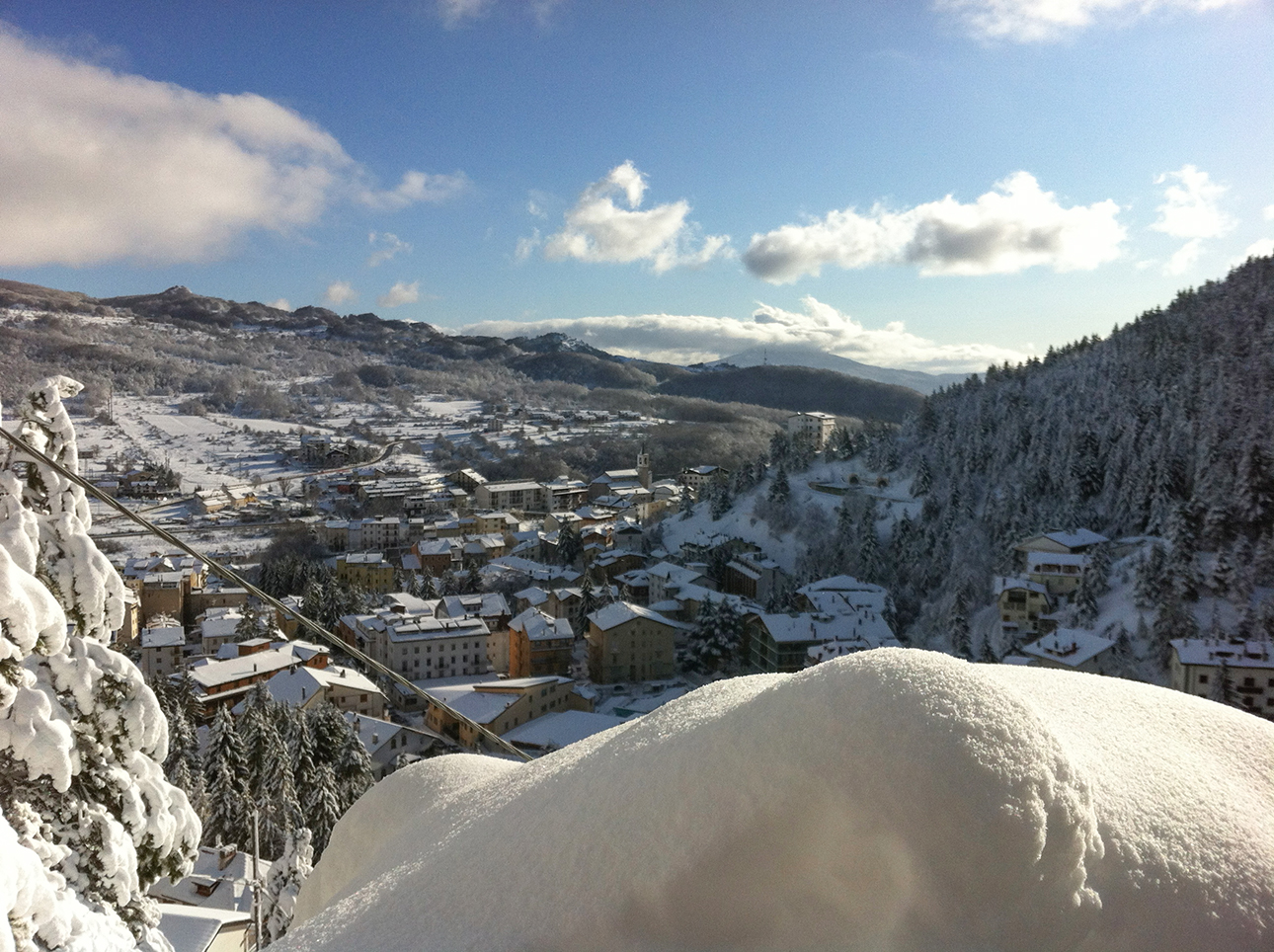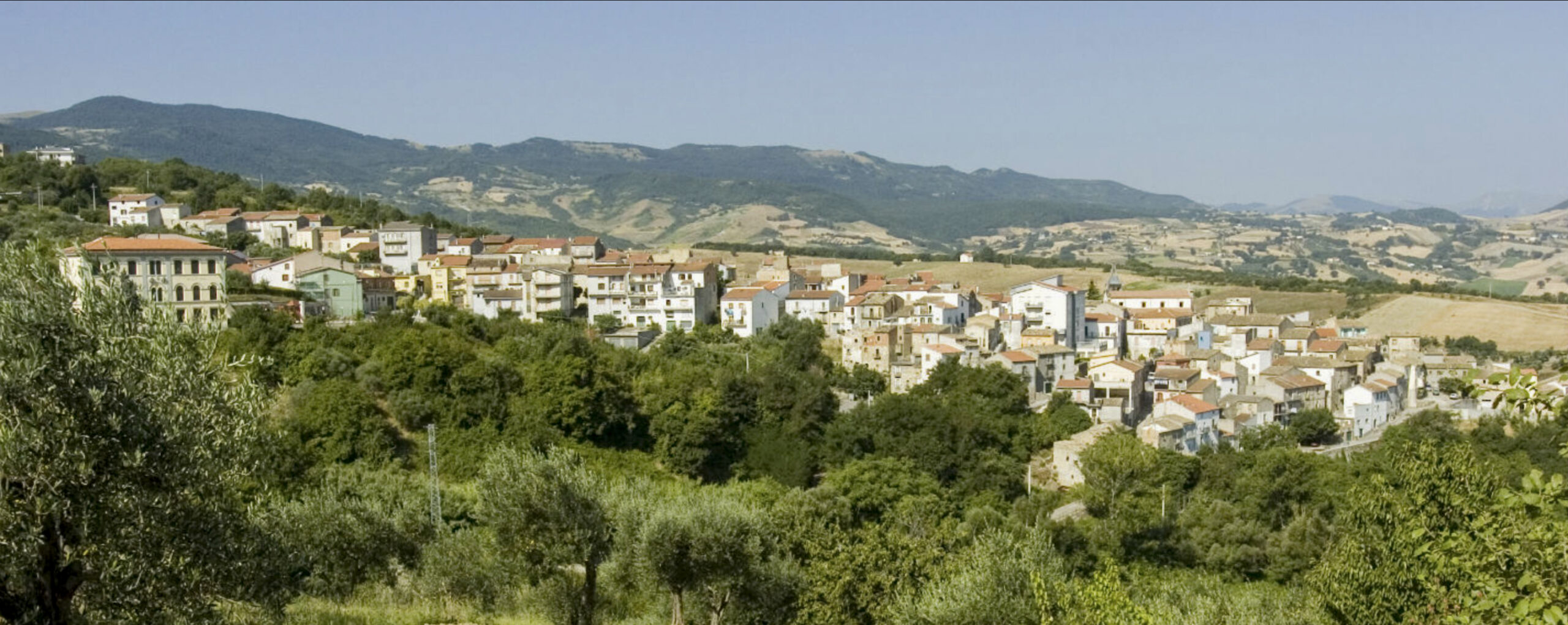-
Roccaraso

By Nancy DeSanti

Roccarosso’s location makes it prime ski country in Abruzzo.
Credit: WikipediaProvince of L’Aquila, Region of Abruzzo
The picturesque small town of Roccaraso is located in the province of L’Aquila. It has approximately 1,524 inhabitants, known as Roccolani. The town, in the Alto Sangro ski area, is the largest ski resort in the central Apennines, 195 kilometers from Rome. It is among the most renowned mountain resorts in central and southern Italy, and it offers tracks for cross-country and downhill skiing.
Roccaraso is the most popular ski resort in Abruzzo, considered as good as the most beautiful ski areas in northern Italy. Thanks to the efficient links to the other ski resorts, such as Rivisondoli, Pescasseroli, Pescocostanzo, Barrea, and Castel di Sangro, the resort of Roccaraso is part of a wider area, called “Comprensorio Sciistico dell’Alto Sangro e dell’Altopiano delle Cinque Miglia,” thus offering more than 150 kilometers of ski slopes and 60 kilometers of cross-country ski trails. The different resorts are linked by more than 30 modern ski lifts and are accessible by using the same ski pass.
This ski area is said to be perfect for all level of skiers, with slopes for beginners, intermediates, or advanced. These slopes are also the site of many national and international ski competitions and are equipped with snowmaking systems in case the weather does not ensure a perfect snow condition, as has happened recently. The 1,000-meter difference in altitude from the town to the peak, called Toppe del Tesoro, provides skiers with an awe-inspiring view of the charming surroundings.In Roccaraso, there is a popular ice-skating rink and the area is equipped with two snow parks, a children’s area with a playground, and other areas for different activities–snow tubing, sledding, bobsledding, snow-racket walks, stationary biking on the snow, and Nordic walking.
Roccaraso is important historically, too. The town is on the site of a route through a nearby mountain pass, where Hannibal’s army is recorded to have travelled. The great strategic importance of the area since antiquity is shown by the presence of Caracini (an Italic population) as indicated by tombs from the 5th-4th centuries B.C.
In the Middle Ages, Roccaraso was under the control of the Benedictine monastery of San Vincenzo al Volturno. Later, Saracen raids obliged the local inhabitants to build castles where they could take refuge.
But the plague in 1656 wiped out one-fourth of the population. There is a legend that a miracle by San Rocco saved the rest of the inhabitants and, miraculously, the church they built in his honor is the only building that survived the destruction of World War II. The town was destroyed by the bombing, which caused the loss of “Interalia,” a theater built in 1698 and one of the oldest in Italy.
Earlier, a flourishing textile economy had developed over the centuries and created prosperity, but the decline of the agricultural and pastoral economy in the latter part of the 19th century started a mass emigration.
The darkest moment in the town’s history came in 1943 when the Germans established their headquarters there. A massive bombing by American forces destroyed 98 percent of the place. For revenge, the Germans destroyed nearby Pietransieri, killing 127 civilians.
After the extensive destruction by WW2 bombings, today the small center has been completely modernized, except for the district called Terra Vecchia (the ancient fortified borough) with remains of a tower, and in the lower part, the small church of San Rocco.
However, since the beginning of the 20th century, a steady recovery began with the tourism industry, thanks to a favorable position on the railway line to Naples. The first ski race was held in 1910 and the first ski lift was built in 1936.
Roccaraso was in the news recently when a wild bear known affectionately as Juan Carrito died after being struck by a car. The incident occurred on a highway leading to Castel Di Sangro, near the Roccaraso tunnel. Known as the “biscuit-loving bear,” Juan Carrito was famous for his playful nature and raids in search of food.
The animal’s increasingly daring forays into urban areas in search of food prompted park authorities to relocate him — twice — to a remote area of the mountains. However, Juan Carrito surprised everyone by making the 150-kilometer trek back to his stomping ground of Roccaraso. Tracked by a radio collar, the Marsican bear was noted for his lack of fear of humans and his playful nature towards dogs.
Aside from the region’s sentimental attachment to Juan Carrito, his loss is a further blow to the critically endangered Marsican bear, a subspecies of the brown bear. There are reportedly only about 30 of the animals left in existence, compared to 100 in 1980.
What to See
- Church of Santa Maria Assunta
- The Church of San Rocco was built in 1656 to give thanks to the saint who saved the population from a terrible plague
Important Dates
- August 13 — Feast of Sant’Ippolito of Rome, the patron saint.
Italiano

Tradotto da Ennio Di Tullio
Provincia dell’Aquila, Regione Abruzzo
Il pittoresco paesino di Roccaraso si trova in provincia dell’Aquila. Conta circa 1.524 abitanti, detti Roccolani. La località, nel comprensorio sciistico dell’Alto Sangro, è la più grande stazione sciistica dell’Appennino centrale, a 195 chilometri da Roma. E’ tra le località montane più rinomate del centro e sud Italia, e offre piste per lo sci di fondo e di discesa.
Grazie agli efficienti collegamenti con le altre località sciistiche, come Rivisondoli, Pescasseroli, Pescocostanzo, Barrea e Castel di Sangro, la località di Roccaraso fa parte di un comprensorio più ampio, denominato “Comprensorio Sciistico dell’Alto Sangro e dell’Altopiano delle Cinque Miglia”, offrendo così più di 150 chilometri di piste da sci e 60 chilometri di piste per lo sci di fondo. Le diverse località sono collegate da più di 30 moderni impianti di risalita e sono accessibili utilizzando lo stesso ski pass.
Si dice che questo comprensorio sciistico sia perfetto per tutti i livelli di sciatori, con piste per principianti, intermedi, o avanzati. Queste piste sono anche sede di numerose gare sciistiche nazionali ed internazionali e sono dotate di impianti di innevamento programmato nel caso in cui le condizioni meteorologiche non garantissero un innevamento perfetto, come è accaduto di recente. Il dislivello di 1.000 metri dal paese alla vetta, denominata Toppe del Tesoro, offre agli sciatori una vista mozzafiato sull’incantevole paesaggio circostante.
A Roccaraso è presente una rinomata pista di pattinaggio sul ghiaccio e la zona è attrezzata con due snowpark, un’area bimbi con parco giochi e altre aree per diverse attività: snow tubing, slittino e bob, passeggiate con le ciaspole, cyclette sulla neve , e nordic walking. Roccaraso è importante anche storicamente. La città si trova sul sito di un percorso attraverso un vicino passo di montagna, dove si dice che abbia viaggiato l’esercito di Annibale. La grande importanza strategica dell’area fin dall’antichità è dimostrata dalla presenza dei Caracini (popolazione italica) come testimoniano tombe del V-IV secolo a.C.
Nel Medioevo Roccaraso era sotto il controllo del monastero benedettino di San Vincenzo al Volturno. In seguito le incursioni saracene costrinsero gli abitanti del luogo a costruire castelli dove rifugiarsi.
Ma la peste del 1656 spazzò via un quarto della popolazione. Narra la leggenda che un miracolo di San Rocco salvò il resto degli abitanti e, miracolosamente, la chiesa da loro costruita in suo onore è l’unico edificio sopravvissuto alla distruzione della seconda guerra mondiale. Il paese fu distrutto dai bombardamenti che portarono alla perdita di “Interalia”, teatro costruito nel 1698 e tra i più antichi d’Italia.
In precedenza, una fiorente economia tessile si era sviluppata nel corso dei secoli e aveva creato prosperità, ma il declino dell’economia agricola e pastorale nell’ultima parte del XIX secolo diede inizio a un’emigrazione di massa.
Il momento più buio nella storia della città arrivò nel 1943 quando i tedeschi vi stabilirono il loro quartier generale. Un massiccio bombardamento da parte delle forze americane ha distrutto il 98% del luogo. Per vendetta i tedeschi distrussero la vicina Pietransieri, uccidendo 127 civili.
Dopo le ingenti distruzioni causate dai bombardamenti della seconda guerra mondiale, oggi il piccolo centro è stato completamente rimodernato, ad eccezione del quartiere denominato Terra Vecchia (l’antico borgo fortificato) con i resti di una torre, e nella parte inferior, la chiesetta di San Rocco.
A ll’inizio del ‘900 iniziò una costante ripresa dell’industria del turismo, grazie ad una posizione favorevole sulla linea ferroviaria per Napoli. La prima gara di sci si tenne nel 1910 e il primo impianto di risalita fu costruito nel 1936.
Roccaraso ha fatto notizia di recente quando un orso selvatico noto affettuosamente come Juan Carrito è morto dopo essere stato investito da un’auto. L’incidente è avvenuto sull’autostrada che porta a Castel Di Sangro, nei pressi della galleria di Roccaraso. Conosciuto come “l’orso amante dei biscotti”, Juan Carrito era famoso per la sua natura giocosa e le sue incursioni in cerca di cibo. Tuttavia, Juan Carrito ha sorpreso tutti facendo il viaggio di 150 chilometri per tornare al suo terreno calpestante di Roccaraso.
Seguito da collare radio, l’orso marsicano era noto per la sua mancanza di paura degli umani e per la sua natura giocosa nei confronti dei cani. Si dice che siano solo trenta degli animali rimasti inesistenti, rispetto ai 100 del 1980.
Le attrazioni del luogo:
- Chiesa di Santa Maria Assunta
- Chiesa di San Rocco fu costruita nel 1656 per ringraziare il santo per aver salvato la popolazione dalla grande peste
Date da ricordare:
- 13 agosto — Festa di Sant’Ippolito di Roma, patrono
May/June 2023
-
Acquaviva Collecroce

By Nancy DeSanti

A view of Acquaviva Colleroce
Credit: e-borghi.com
Province of Campobasso, Region of Molise
The small town of Acquaviva Collecroce is located in the province of Campobasso, between the Biferno and Trignorivers. It has approximately 644 inhabitants, known as Acquavivesi. The town is known for the cultivation of small, dark zerniza figs, as well as fennel and white celery.
Acquaviva Collecroce is one of the three municipalities in Molise of Croatian origin (Montemitro and San Felice del Molise are the other two). The presence of Slavic peoples was first noted in the 16th century. They arrived in Italy at the same time as the Albanians, between the end of the 15th century and the beginning of the 16th century, coming perhaps from the valley of the Neretva River, in current Bosnia & Herzegovina and Croatia.
Most of the Molisani Croats speak a particular Croatian dialect (known as simply na-našo or naš jezik, meaning “our language”) as well as Italian. There are differences in the dialects of the three towns, but they all descend from the Shtokavian–Ikavian dialect of Dalmatia. Linguists consider the dialect to be an endangered diaspora language.
Earlier, in the 12th century, Acquaviva was a base for the Knights of Malta. Although there is evidence of an earlier Slavic settlement in 1297, it is believed that the current inhabitants are not their descendants, but rather come from later migrations in the 15th and 16th centuries. Historians think these migrations may have been caused by Ottoman incursions into the Balkans.
The presence of abundant fresh water had evidently determined both the choice of the site for the settlement and the name of the town Acquaviva, which subsequently added Collecroce to distinguish it from other towns in Italy with the same name.
The village has preserved some beautiful traditions of its Slavic heritage. On the first of May, there is the Festa del Maja, when a puppet (the pagliara maja) is carried along the alleys as a good omen for the harvest. A large straw basket, decorated with green fronds, fresh flowers, and first fruits, parades through the streets of the village bringing good wishes accompanied by songs and dances. At Christmas time, the Slavic custom of the Smarceka is repeated, when a torch is lit on a huge tree trunk near the door of the parish church.
Many of the town’s inhabitants emigrated in two flows during the 20th century. The first emigration took place between roughly 1900-1920, with the emigres heading towards the United States and Argentina. The second major flow took place in the 1950s, chiefly to Australia.
What to See
- A medieval stone, of unknown origin, with the famous “magical square” containing the five-letter words “Rotas Opera Tenet Arepo Sator”, can be read right to left, left to right, top to bottom, and bottom to top.
- Santa Giusta is an ancient church that was the refuge of Abruzzese shepherds.
Important Dates
- May 1 — Festa del Maja
- September 29 — Feast of St. Michael the Archangel
Italiano

Tradotto da Ennio Di Tullio
Provincia di Campobasso, Regione Molise
Il piccolo comune di Acquaviva Collecroce si trova in provincia di Campobasso, tra i fiumi Biferno e Trigno. Conta circa 644 abitanti, detti Acquavivesi. Il paese è noto per la coltivazione di fichi piccoli, neri zerniza, oltre a finocchi e sedani bianchi.
Acquaviva Collecroce è uno dei tre comuni molisani di origine croata (Montemitro e San Felice del Molise sono gli altri due). La presenza di popoli slavi fu notata per la prima volta nel XVI secolo. Arrivarono in Italia contemporaneamente agli albanesi, tra la fine del XV secolo e l’inizio del XVI secolo, provenienti forse dalla valle del fiume Neretva, nell’attuale Bosnia ed Erzegovina e Croazia.
La maggior parte dei croati molisani parla un particolare dialetto croato (noto semplicemente na-našo o naš jezik, che significa “la nostra lingua”) oltre all’italiano. Ci sono differenze nei dialetti delle tre città, ma tutti discendono dal dialetto stocavo-icavo della Dalmazia. I linguisti considerano il dialetto una lingua della diaspora in via di estinzione.
In precedenza, nel XII secolo, Acquaviva era una base per i Cavalieri di Malta. Sebbene ci siano prove di un precedente insediamento slavo nel 1297, si ritiene che gli attuali abitanti non siano i loro discendenti, ma piuttosto provengono da migrazioni successive nel XV e XVI secolo. Gli storici pensano che queste migrazioni possano essere state causate dalle incursioni ottomane nei Balcani.
La presenza di abbondanta fresca acqua aveva evidentemente determinato sia la scelta del sito per l’insediamento, sia il nome del paese Acquaviva, al quale successivamente si aggiunse Collecroce per distinguerlo da altri paesi in Italia con lo stesso nome.
Il paese conserva alcune belle tradizioni del suo retaggio slavo. Il primo Maggio, si svolge la Festa del Maja, quando un fantoccio (la pagliara maja) viene portato lungo i vicoli come buon auspicio per il raccolto. Un grande cesto di paglia addobbato con fronde verdi, fiori freschi, e primizie sfila per le vie del paese portando gli auguri accompagnato da canti e balli nel periodo natalizio si ripete l’usanza slava della Smarceka, quando si accende una torcia su un enorme tronco d’albero vicino alla porta della chiesa parrocchiale.
Molti degli abitanti della città sono emigrati in due flussi nel corso del XX secolo. La prima emigrazione è avvenuta all’incirca tra il 1900 e il 1920, con gli emigrati diretti verso gli Stati Uniti e l’Argentina. Il secondo grande flusso ebbe luogo negli anni ’50, principalmente in Australia.
Le attrazioni del luogo:
- Una pietra medievale, di origine sconosciuta, con il famoso “quadrato magico” contenente le parole di Una pietra medievale, di origine sconosciuta, con il famoso “quadrato magico” contenente le parole di cinque lettere “Rotas Opera Tenet Arepo Sator”, possono essere lette da destra a sinistra, da sinistra a destra, dall’alto in basso, e dal basso a superiore.
- Santa Giusta è antica chiesa che fu rifugio dei pastori abruzzesi.
Date da ricordare:
- 1 maggio — Festa del Maja
- 29 septembre — Festa di San Michele Arcangelo
May/June 2023
-
AMHS Membership
By Lynn Sorbara, 2nd Vice President-Membership
New Members We warmly welcome the following new members: Clara Cuonzo, Sofia DeLuca, and Peter Tompa. Birthdays Compleanni a Maggio
Michael Iademarco, May 1; Rose Marie DeMarco-Evans, May 6; Joseph Scafetta, Jr., May 10; Amy Antonelli, May 15; Kathlyn Nudi and Victor Ferrante, May 16; Marcella Finelli, May 17; Robert Woolley, May 19; Peter Bell, May 20; Rocco Del Monaco, Giulia Michonski, and Abby Cuviello, May 21; Aldo D’Ottavio and Cora Williams, May 22; Cristina Scalzitti and John Dunkle, May 25; Ennio DiTullio and Richard Leiobold, May 29; and Renato Orcino, May 30.Compleanni a Giugno
Rev. Frank Donio, June 3; Joseph Lupo and Jo-Ann Pilardi, June 9; Alberto Paolantonio and Robert Tobias, June 10; Ruth Bergman Spellane, June 14; Sharon Moran, June 17; Harry Piccariello and Joan Galles, June 24; Justin Smith, June 25; Omero Sabatini, June 26; Barbara Bernero and Rita Orcino, June 28; and Laura Gentile, June 30.Anniversaries Anniversari a Maggio
Francesco & Anna Isgro, May 19; Mario & Carmen Ciccone, May 27: and Carmine Spellane & Ruth Bergman, May 29; Ordination of Rev. John V. DiBacco Jr., May 13.Anniversari a Giugno
Omero & Belinda Sabatini, June 6; Jeff & Macarena Clark, June 16; Anthony & Elodia D’Onofrio, June 25; Lucio & Edvige D’Andrea, June 27; and Roger & Joan Galles, June 30.Membership Information Category # of Persons
Associate (Couple): 4 x 2 = 4
Associate (Individual): 38
General (Couple): 50 x 2 = 100
General (Individual): 80
Honorary: 9
Scholarship: 2
Student: 6
Total Membership: 239
May/June 2023







